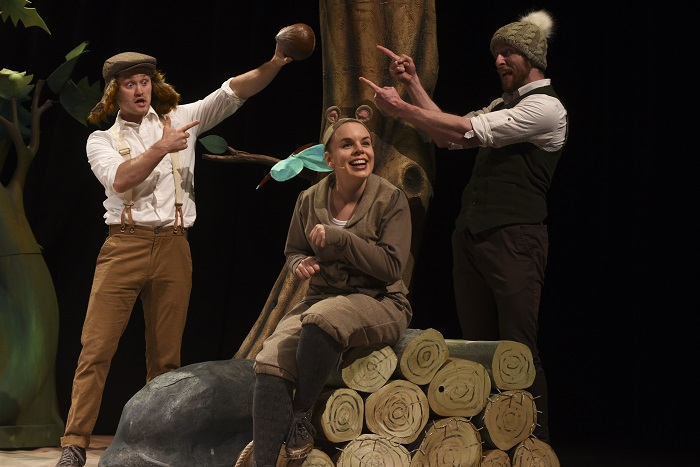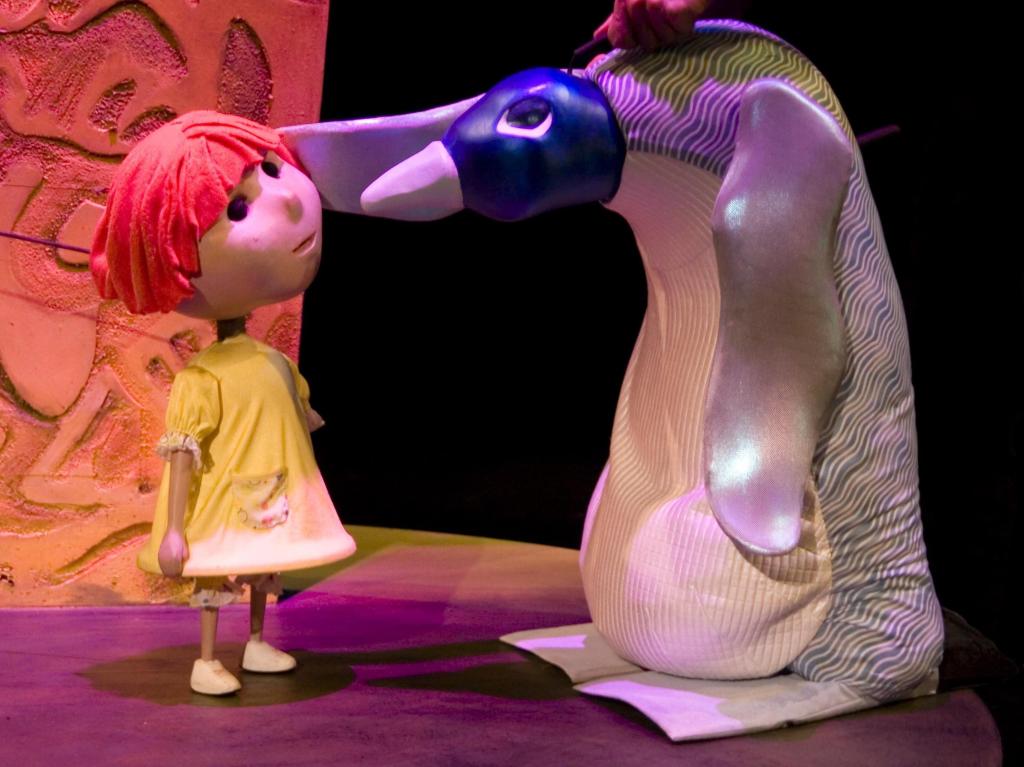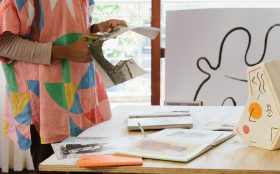Jamie and Penguin feature in Spare Parts Puppet Theatre’s The Night Zoo. Image supplied.
From audience participation and direct address, to utilising humour, music and song, children’s theatre is a mixed bag of theatrical conventions used to engage young people.
Usually aimed at children under 12, children’s theatre can be focused on educating young minds or creating a fun space in which to interact with art. Not only does theatre feed creativity, it also cultivates a child’s empathy, enables new ideas to flourish and broadens the scope of their imagination.
But how does one get into a career that demands compassion and playfulness?
Natalie Bell, Executive Producer at Spare Parts Puppet Theatre, told ArtsHub that moving into children’s theatre from a 16-year career in screen production was a deliberate and natural move.
‘I have a young family of my own and I am deeply passionate about the impact meaningful art experiences can have on young people, so, when I saw the opportunity at Spare Parts Puppet Theatre I was very excited to transfer my skills into live performance,’ Bell said.
Andrew Threlfall, Director, CDP Theatre Producers, is currently working on the much-loved stage adaptations of Julia Donaldson’s children’s classics The Gruffalo, and The Gruffalo’s Child.
Threlfall said he started his career as a performer. ‘Including performing in work for young audiences. I found that I really enjoyed performing for children and young people – they’re amazingly direct and engaged audiences,’ he told ArtsHub.
‘After some time working in audience research/development and venue management, I joined CDP, initially as Executive Producer. While CDP produces work across the age range, these days we have a growing portfolio of productions for young audiences, and so I have had the opportunity to develop my skills in that very particular area, building on my early experience as a performer.’

Natalie Bell and Andrew Threlfall. Supplied.
FORMAL TRAINING VS LEARNING ON THE JOB
Threlfall acknowledged that it’s generally difficult to find formal training for producing, whether for young audiences or more broadly.
‘Most producers have background in another hands-on role in the industry, whether that’s performing, stage or production management, company management, technical or something else. It certainly prepares you well for the role of a producer, where you need to combine planning and business skills with a broad understanding of the hands on tasks involved in creating, developing, marketing, delivering and touring a work,’ he said.
Bell agreed with Threlfall. ‘I don’t think formal training in children’s theatre production specifically is a requirement.’
She continued, ‘Of course there are aspects of Arts Management and/or Production Management training that are valuable, however passionate, creative and curious people can learn on the job and I would encourage anyone taking this option, to find a mentor (or two) and ask lots of questions.
‘As with my previous positions, it’s all about people. Developing long term relationships, building trust and respect is the most important skill you can bring to any role, including children’s theatre production.’
Career Spotlight: General Manager
A DAY IN THE LIFE
As the Executive Producer in a small to medium company Bell wears many hats.
‘Some days I can be dealing with general business, hiring and contracting staff/artists, overseeing the financial position of the company, fixing IT or computer issues. Every day is different and it’s a very exciting company to work in.’ she explained.
‘We have an in-theatre season, we tour regionally to venues and schools, as well as nationally and international touring. We also have a strong festival and events offering and through our School of Puppetry we reach 9000+ people ranging from young children to professional and emergent artists.
‘Then other days I may be working with the Board or our staff, creating strategic plans or thinking about wild and exciting possibilities for the future of Spare Parts Puppet Theatre.’
Due to a variable number of productions in different stages of development, Threlfall said he doesn’t have a typical day. ‘But a common one would begin with an early morning read through sales reports, show reports and email relating to our overseas tours (we work internationally as well as throughout Australia and New Zealand).
‘Once business hours roll round, it’s time to follow up any issues on running shows which need fast attention; depending on which shows are running locally and where, I might spend some time in the theatre with one of our productions. A big part of my day – like the day of my fellow CDP Director Yolande White – lies around planning.
‘So we’ll be working through future productions over the next six months – three years, looking at pitches, creative plans and itineraries, and working with the team across a wide range of upcoming shows. The evening might finish off with a call to one of our international partners, and then finally the day is done!’

Josh Anderson, Tina Jackson, and Jonathan MacMacMilla in The Gruffalo. Photo by Heidrun Lohr.
HIGHLIGHTS AND LOWLIGHTS
‘Opening a new production is always a highlight,’ said Threlfall, ‘particularly when it’s in a new town, city or country that we haven’t worked in before. But the best part of my job is watching young audiences engage with – and love – our shows. The joy they bring to the process is really wonderful.’
Bell said presenting shows with Western Australian Symphony Orchestra (WASO), Western Australian Museum, and international festivals in Australia and Singapore were exceptional moments in her first year at Spare Parts.
‘For WASO we created a version of Saint-Saëns’ Carnival of the Animals, which featured large puppets and small figurine models set in amongst the orchestra,’ Bell said. ‘There was also digital video and animation that brought the characters to life. The conductor Benjamin Northey contributed to the joy of this performance with his delightful interactions with the puppets.
‘For WA Museum we created a new work, Tom Vickers and the Extraordinary Adventure of his Missing Sock, which explored the intersection of puppetry, object theatre and museum installation in “a choose your own adventure” style performance. Following the metropolitan premiere, the production toured regional WA.
‘We were also thrilled to tour interstate and overseas with our giant handwoven illuminated puppet, Leor in String Symphony. We were invited to be part of the Commonwealth Games Festivals in Brisbane and on the Gold Coast, and Flipside Festival for The Esplanade in Singapore.’
Read: Career spotlight: Lighting designer
SO YOU WANT TO BE A PRODUCER FOR CHILDREN’S THEATRE?
Both producers agreed that you must be bold when it comes to producing theatre for young people. ‘Be brave, bold and grateful,’ Bell advised future producers.
Threlfell encouraged producers to subvert the way they see risk. ‘Ask lots of questions, and don’t be afraid to take sensible risks. Producing is ultimately the business of risk – creative and commercial – and the way to understand those is to start at the ground and really get a handle of how this craft works.’
Spare Parts Puppet Theatre: www.sppt.asn.au
CDP Theatre Producers: www.cdp.com.au





